Business and Business Environment Analysis Report - University ABC
VerifiedAdded on 2021/02/21
|13
|3796
|35
Report
AI Summary
This report provides a comprehensive analysis of the business environment, encompassing various organizational types such as public, non-profit, and private entities, exemplified by TESCO, FairWays, and Bestway Group, respectively. It delves into their purposes, legal structures, and the distinctions between micro, SME, and large enterprises. The report further examines the interconnectedness of organizational functions like marketing, finance, and human resources, and how they align with company objectives and structure. A significant portion of the report is dedicated to assessing the positive and negative impacts of the macro environment, including political, economic, technological, and environmental factors, on business operations. Through internal and external analyses, the report identifies the strengths and weaknesses of specific organizations, highlighting their relationship with external macro factors. The report concludes by summarizing the key findings and insights gained from the analysis.
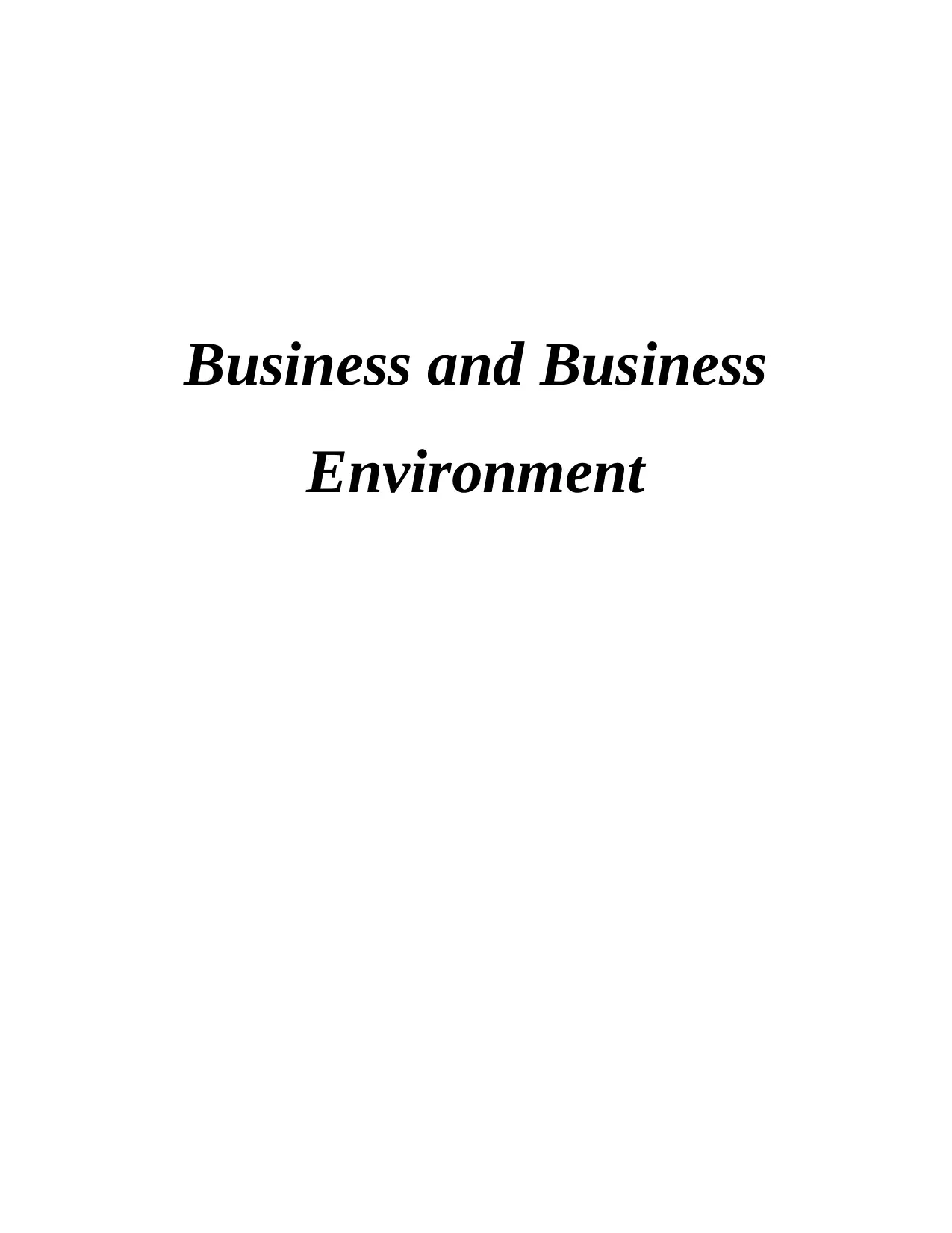
Business and Business
Environment
Environment
Paraphrase This Document
Need a fresh take? Get an instant paraphrase of this document with our AI Paraphraser
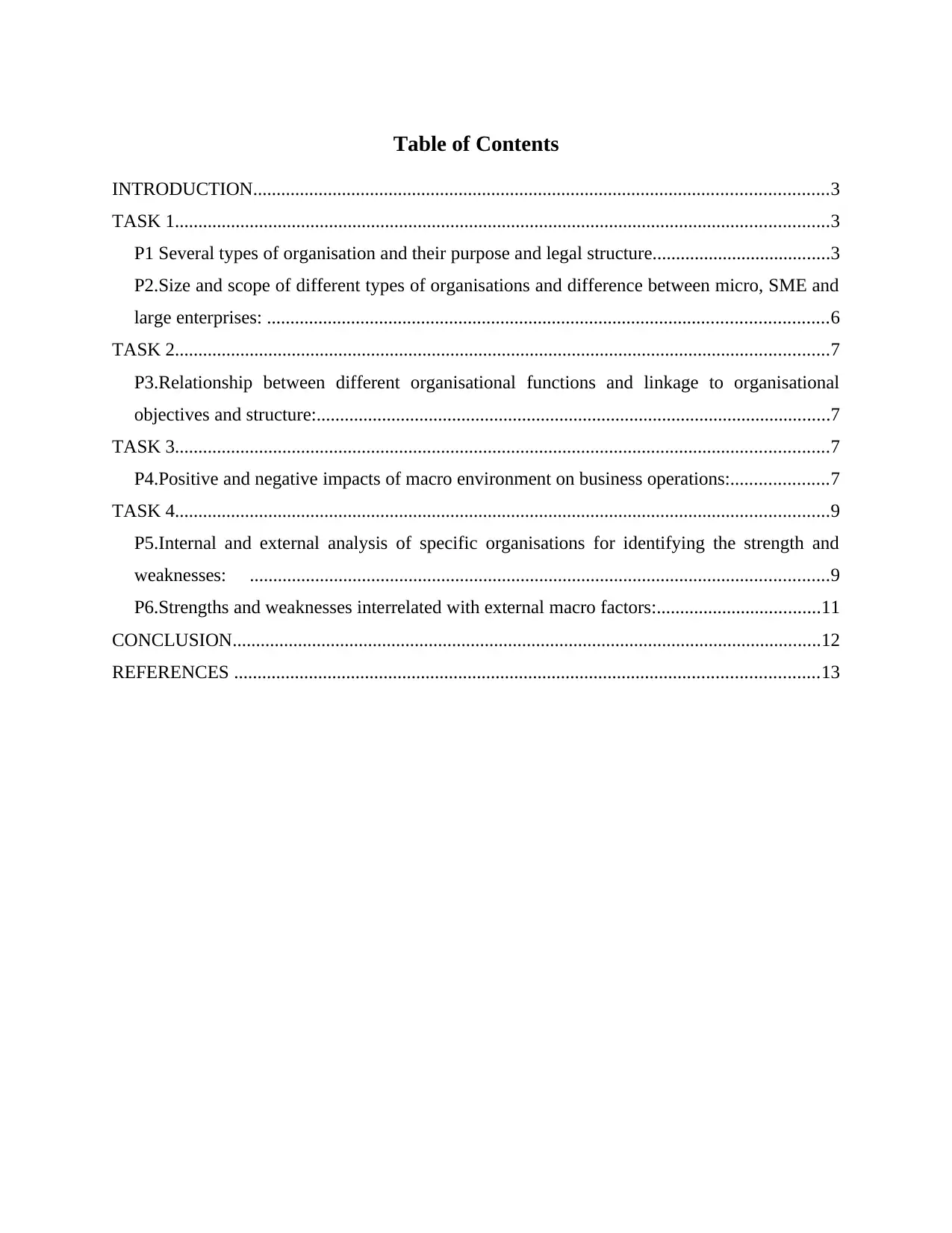
Table of Contents
INTRODUCTION...........................................................................................................................3
TASK 1............................................................................................................................................3
P1 Several types of organisation and their purpose and legal structure......................................3
P2.Size and scope of different types of organisations and difference between micro, SME and
large enterprises: ........................................................................................................................6
TASK 2............................................................................................................................................7
P3.Relationship between different organisational functions and linkage to organisational
objectives and structure:..............................................................................................................7
TASK 3............................................................................................................................................7
P4.Positive and negative impacts of macro environment on business operations:.....................7
TASK 4............................................................................................................................................9
P5.Internal and external analysis of specific organisations for identifying the strength and
weaknesses: ............................................................................................................................9
P6.Strengths and weaknesses interrelated with external macro factors:...................................11
CONCLUSION..............................................................................................................................12
REFERENCES .............................................................................................................................13
INTRODUCTION...........................................................................................................................3
TASK 1............................................................................................................................................3
P1 Several types of organisation and their purpose and legal structure......................................3
P2.Size and scope of different types of organisations and difference between micro, SME and
large enterprises: ........................................................................................................................6
TASK 2............................................................................................................................................7
P3.Relationship between different organisational functions and linkage to organisational
objectives and structure:..............................................................................................................7
TASK 3............................................................................................................................................7
P4.Positive and negative impacts of macro environment on business operations:.....................7
TASK 4............................................................................................................................................9
P5.Internal and external analysis of specific organisations for identifying the strength and
weaknesses: ............................................................................................................................9
P6.Strengths and weaknesses interrelated with external macro factors:...................................11
CONCLUSION..............................................................................................................................12
REFERENCES .............................................................................................................................13
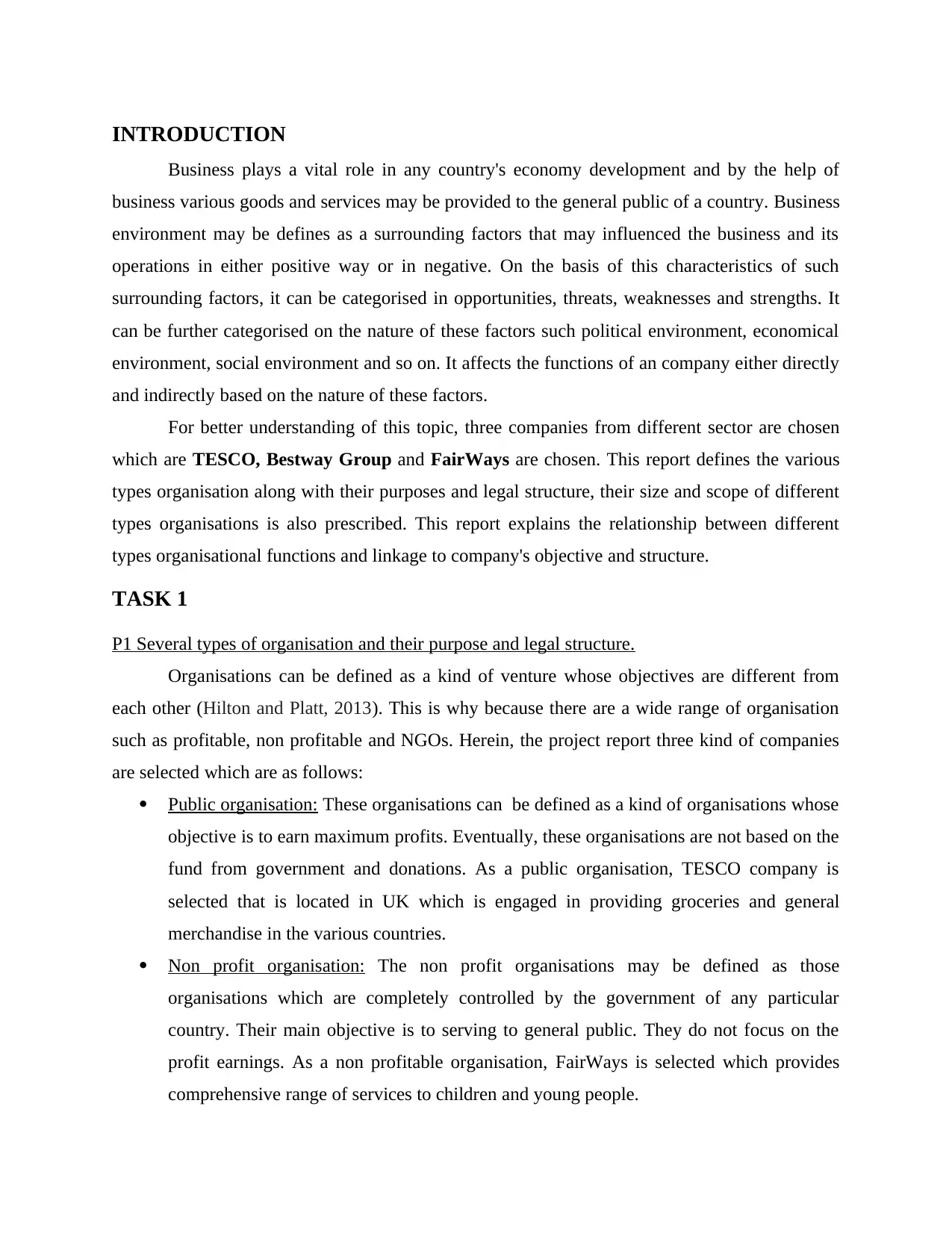
INTRODUCTION
Business plays a vital role in any country's economy development and by the help of
business various goods and services may be provided to the general public of a country. Business
environment may be defines as a surrounding factors that may influenced the business and its
operations in either positive way or in negative. On the basis of this characteristics of such
surrounding factors, it can be categorised in opportunities, threats, weaknesses and strengths. It
can be further categorised on the nature of these factors such political environment, economical
environment, social environment and so on. It affects the functions of an company either directly
and indirectly based on the nature of these factors.
For better understanding of this topic, three companies from different sector are chosen
which are TESCO, Bestway Group and FairWays are chosen. This report defines the various
types organisation along with their purposes and legal structure, their size and scope of different
types organisations is also prescribed. This report explains the relationship between different
types organisational functions and linkage to company's objective and structure.
TASK 1
P1 Several types of organisation and their purpose and legal structure.
Organisations can be defined as a kind of venture whose objectives are different from
each other (Hilton and Platt, 2013). This is why because there are a wide range of organisation
such as profitable, non profitable and NGOs. Herein, the project report three kind of companies
are selected which are as follows:
Public organisation: These organisations can be defined as a kind of organisations whose
objective is to earn maximum profits. Eventually, these organisations are not based on the
fund from government and donations. As a public organisation, TESCO company is
selected that is located in UK which is engaged in providing groceries and general
merchandise in the various countries.
Non profit organisation: The non profit organisations may be defined as those
organisations which are completely controlled by the government of any particular
country. Their main objective is to serving to general public. They do not focus on the
profit earnings. As a non profitable organisation, FairWays is selected which provides
comprehensive range of services to children and young people.
Business plays a vital role in any country's economy development and by the help of
business various goods and services may be provided to the general public of a country. Business
environment may be defines as a surrounding factors that may influenced the business and its
operations in either positive way or in negative. On the basis of this characteristics of such
surrounding factors, it can be categorised in opportunities, threats, weaknesses and strengths. It
can be further categorised on the nature of these factors such political environment, economical
environment, social environment and so on. It affects the functions of an company either directly
and indirectly based on the nature of these factors.
For better understanding of this topic, three companies from different sector are chosen
which are TESCO, Bestway Group and FairWays are chosen. This report defines the various
types organisation along with their purposes and legal structure, their size and scope of different
types organisations is also prescribed. This report explains the relationship between different
types organisational functions and linkage to company's objective and structure.
TASK 1
P1 Several types of organisation and their purpose and legal structure.
Organisations can be defined as a kind of venture whose objectives are different from
each other (Hilton and Platt, 2013). This is why because there are a wide range of organisation
such as profitable, non profitable and NGOs. Herein, the project report three kind of companies
are selected which are as follows:
Public organisation: These organisations can be defined as a kind of organisations whose
objective is to earn maximum profits. Eventually, these organisations are not based on the
fund from government and donations. As a public organisation, TESCO company is
selected that is located in UK which is engaged in providing groceries and general
merchandise in the various countries.
Non profit organisation: The non profit organisations may be defined as those
organisations which are completely controlled by the government of any particular
country. Their main objective is to serving to general public. They do not focus on the
profit earnings. As a non profitable organisation, FairWays is selected which provides
comprehensive range of services to children and young people.
⊘ This is a preview!⊘
Do you want full access?
Subscribe today to unlock all pages.

Trusted by 1+ million students worldwide
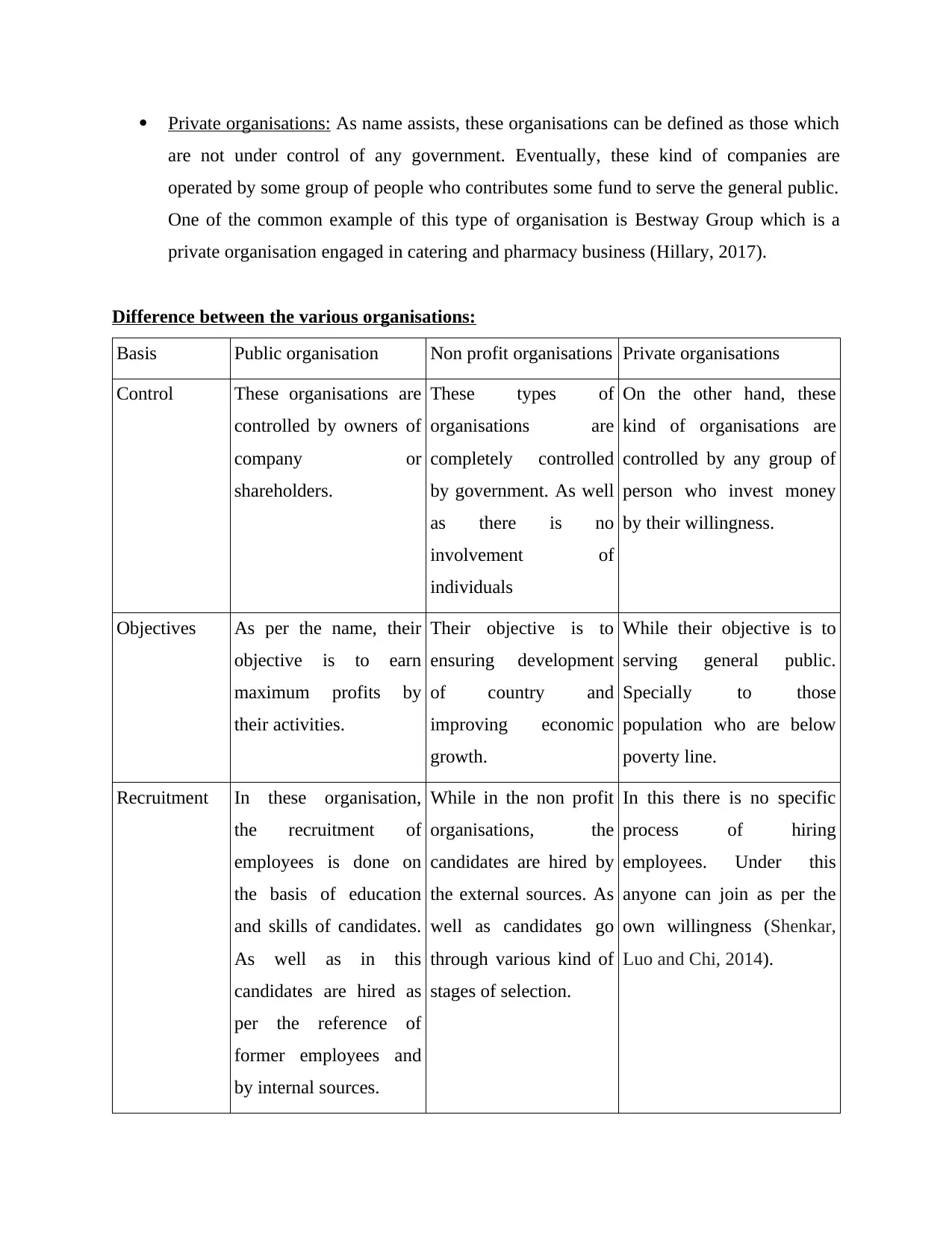
Private organisations: As name assists, these organisations can be defined as those which
are not under control of any government. Eventually, these kind of companies are
operated by some group of people who contributes some fund to serve the general public.
One of the common example of this type of organisation is Bestway Group which is a
private organisation engaged in catering and pharmacy business (Hillary, 2017).
Difference between the various organisations:
Basis Public organisation Non profit organisations Private organisations
Control These organisations are
controlled by owners of
company or
shareholders.
These types of
organisations are
completely controlled
by government. As well
as there is no
involvement of
individuals
On the other hand, these
kind of organisations are
controlled by any group of
person who invest money
by their willingness.
Objectives As per the name, their
objective is to earn
maximum profits by
their activities.
Their objective is to
ensuring development
of country and
improving economic
growth.
While their objective is to
serving general public.
Specially to those
population who are below
poverty line.
Recruitment In these organisation,
the recruitment of
employees is done on
the basis of education
and skills of candidates.
As well as in this
candidates are hired as
per the reference of
former employees and
by internal sources.
While in the non profit
organisations, the
candidates are hired by
the external sources. As
well as candidates go
through various kind of
stages of selection.
In this there is no specific
process of hiring
employees. Under this
anyone can join as per the
own willingness (Shenkar,
Luo and Chi, 2014).
are not under control of any government. Eventually, these kind of companies are
operated by some group of people who contributes some fund to serve the general public.
One of the common example of this type of organisation is Bestway Group which is a
private organisation engaged in catering and pharmacy business (Hillary, 2017).
Difference between the various organisations:
Basis Public organisation Non profit organisations Private organisations
Control These organisations are
controlled by owners of
company or
shareholders.
These types of
organisations are
completely controlled
by government. As well
as there is no
involvement of
individuals
On the other hand, these
kind of organisations are
controlled by any group of
person who invest money
by their willingness.
Objectives As per the name, their
objective is to earn
maximum profits by
their activities.
Their objective is to
ensuring development
of country and
improving economic
growth.
While their objective is to
serving general public.
Specially to those
population who are below
poverty line.
Recruitment In these organisation,
the recruitment of
employees is done on
the basis of education
and skills of candidates.
As well as in this
candidates are hired as
per the reference of
former employees and
by internal sources.
While in the non profit
organisations, the
candidates are hired by
the external sources. As
well as candidates go
through various kind of
stages of selection.
In this there is no specific
process of hiring
employees. Under this
anyone can join as per the
own willingness (Shenkar,
Luo and Chi, 2014).
Paraphrase This Document
Need a fresh take? Get an instant paraphrase of this document with our AI Paraphraser
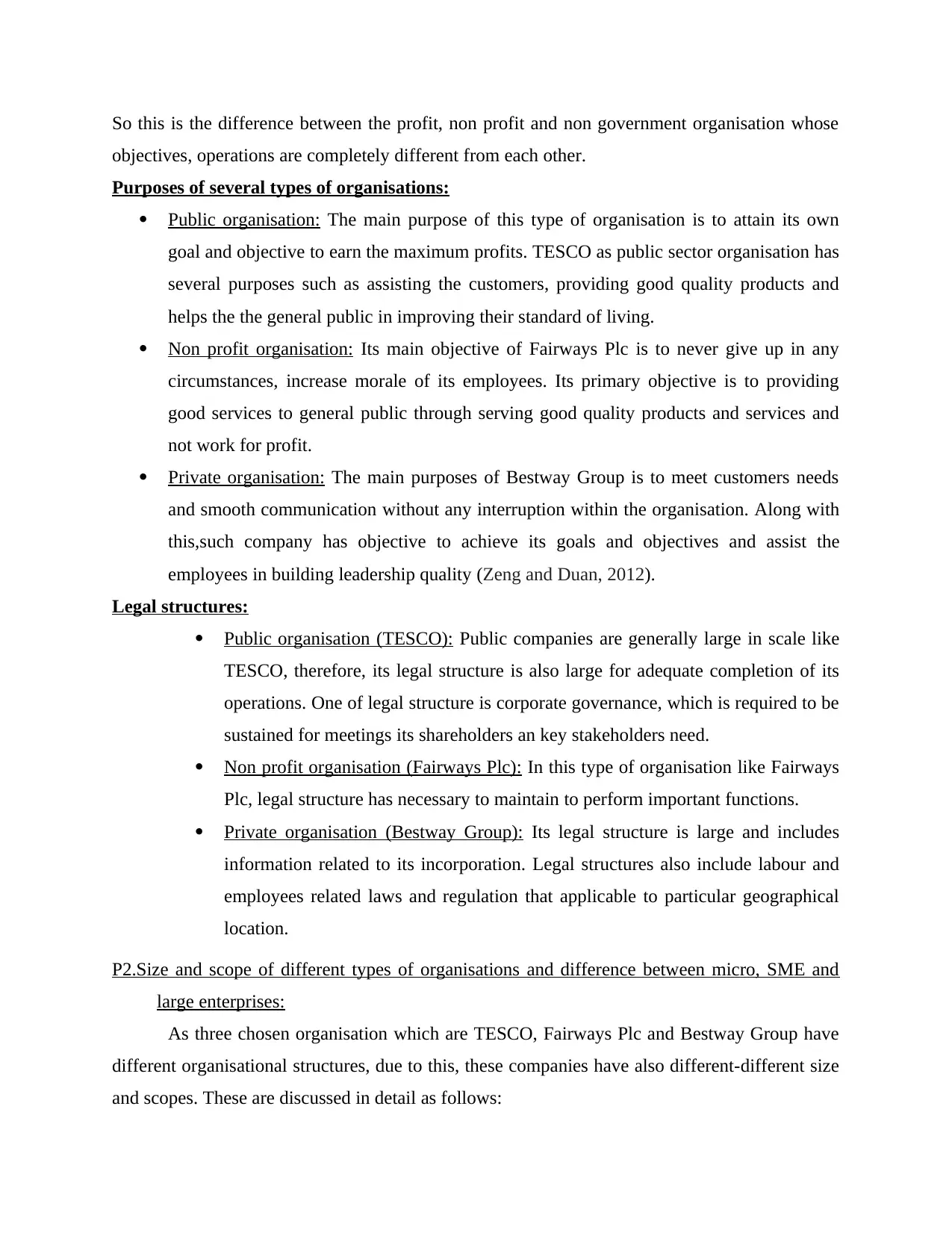
So this is the difference between the profit, non profit and non government organisation whose
objectives, operations are completely different from each other.
Purposes of several types of organisations:
Public organisation: The main purpose of this type of organisation is to attain its own
goal and objective to earn the maximum profits. TESCO as public sector organisation has
several purposes such as assisting the customers, providing good quality products and
helps the the general public in improving their standard of living.
Non profit organisation: Its main objective of Fairways Plc is to never give up in any
circumstances, increase morale of its employees. Its primary objective is to providing
good services to general public through serving good quality products and services and
not work for profit.
Private organisation: The main purposes of Bestway Group is to meet customers needs
and smooth communication without any interruption within the organisation. Along with
this,such company has objective to achieve its goals and objectives and assist the
employees in building leadership quality (Zeng and Duan, 2012).
Legal structures:
Public organisation (TESCO): Public companies are generally large in scale like
TESCO, therefore, its legal structure is also large for adequate completion of its
operations. One of legal structure is corporate governance, which is required to be
sustained for meetings its shareholders an key stakeholders need.
Non profit organisation (Fairways Plc): In this type of organisation like Fairways
Plc, legal structure has necessary to maintain to perform important functions.
Private organisation (Bestway Group): Its legal structure is large and includes
information related to its incorporation. Legal structures also include labour and
employees related laws and regulation that applicable to particular geographical
location.
P2.Size and scope of different types of organisations and difference between micro, SME and
large enterprises:
As three chosen organisation which are TESCO, Fairways Plc and Bestway Group have
different organisational structures, due to this, these companies have also different-different size
and scopes. These are discussed in detail as follows:
objectives, operations are completely different from each other.
Purposes of several types of organisations:
Public organisation: The main purpose of this type of organisation is to attain its own
goal and objective to earn the maximum profits. TESCO as public sector organisation has
several purposes such as assisting the customers, providing good quality products and
helps the the general public in improving their standard of living.
Non profit organisation: Its main objective of Fairways Plc is to never give up in any
circumstances, increase morale of its employees. Its primary objective is to providing
good services to general public through serving good quality products and services and
not work for profit.
Private organisation: The main purposes of Bestway Group is to meet customers needs
and smooth communication without any interruption within the organisation. Along with
this,such company has objective to achieve its goals and objectives and assist the
employees in building leadership quality (Zeng and Duan, 2012).
Legal structures:
Public organisation (TESCO): Public companies are generally large in scale like
TESCO, therefore, its legal structure is also large for adequate completion of its
operations. One of legal structure is corporate governance, which is required to be
sustained for meetings its shareholders an key stakeholders need.
Non profit organisation (Fairways Plc): In this type of organisation like Fairways
Plc, legal structure has necessary to maintain to perform important functions.
Private organisation (Bestway Group): Its legal structure is large and includes
information related to its incorporation. Legal structures also include labour and
employees related laws and regulation that applicable to particular geographical
location.
P2.Size and scope of different types of organisations and difference between micro, SME and
large enterprises:
As three chosen organisation which are TESCO, Fairways Plc and Bestway Group have
different organisational structures, due to this, these companies have also different-different size
and scopes. These are discussed in detail as follows:
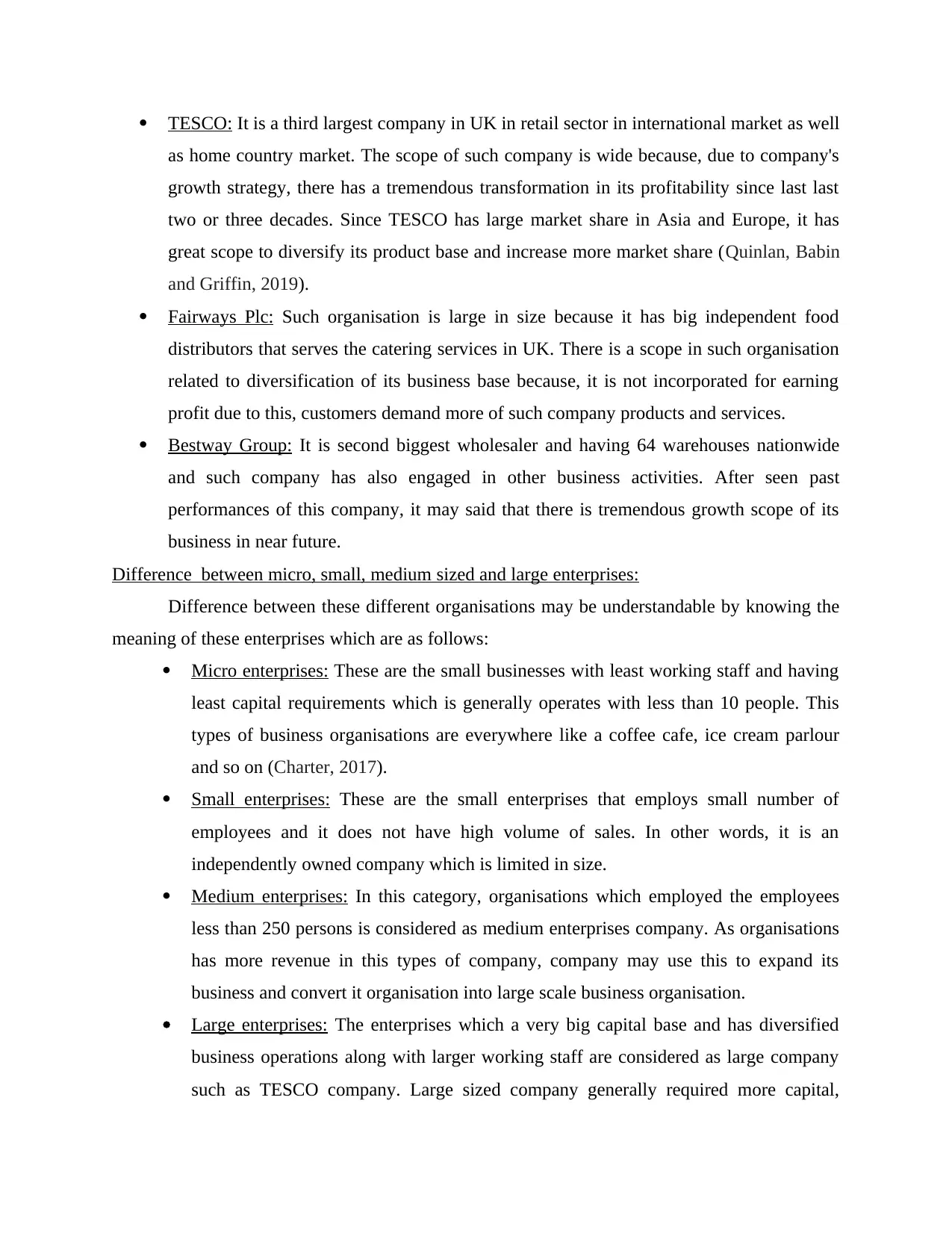
TESCO: It is a third largest company in UK in retail sector in international market as well
as home country market. The scope of such company is wide because, due to company's
growth strategy, there has a tremendous transformation in its profitability since last last
two or three decades. Since TESCO has large market share in Asia and Europe, it has
great scope to diversify its product base and increase more market share (Quinlan, Babin
and Griffin, 2019).
Fairways Plc: Such organisation is large in size because it has big independent food
distributors that serves the catering services in UK. There is a scope in such organisation
related to diversification of its business base because, it is not incorporated for earning
profit due to this, customers demand more of such company products and services.
Bestway Group: It is second biggest wholesaler and having 64 warehouses nationwide
and such company has also engaged in other business activities. After seen past
performances of this company, it may said that there is tremendous growth scope of its
business in near future.
Difference between micro, small, medium sized and large enterprises:
Difference between these different organisations may be understandable by knowing the
meaning of these enterprises which are as follows:
Micro enterprises: These are the small businesses with least working staff and having
least capital requirements which is generally operates with less than 10 people. This
types of business organisations are everywhere like a coffee cafe, ice cream parlour
and so on (Charter, 2017).
Small enterprises: These are the small enterprises that employs small number of
employees and it does not have high volume of sales. In other words, it is an
independently owned company which is limited in size.
Medium enterprises: In this category, organisations which employed the employees
less than 250 persons is considered as medium enterprises company. As organisations
has more revenue in this types of company, company may use this to expand its
business and convert it organisation into large scale business organisation.
Large enterprises: The enterprises which a very big capital base and has diversified
business operations along with larger working staff are considered as large company
such as TESCO company. Large sized company generally required more capital,
as home country market. The scope of such company is wide because, due to company's
growth strategy, there has a tremendous transformation in its profitability since last last
two or three decades. Since TESCO has large market share in Asia and Europe, it has
great scope to diversify its product base and increase more market share (Quinlan, Babin
and Griffin, 2019).
Fairways Plc: Such organisation is large in size because it has big independent food
distributors that serves the catering services in UK. There is a scope in such organisation
related to diversification of its business base because, it is not incorporated for earning
profit due to this, customers demand more of such company products and services.
Bestway Group: It is second biggest wholesaler and having 64 warehouses nationwide
and such company has also engaged in other business activities. After seen past
performances of this company, it may said that there is tremendous growth scope of its
business in near future.
Difference between micro, small, medium sized and large enterprises:
Difference between these different organisations may be understandable by knowing the
meaning of these enterprises which are as follows:
Micro enterprises: These are the small businesses with least working staff and having
least capital requirements which is generally operates with less than 10 people. This
types of business organisations are everywhere like a coffee cafe, ice cream parlour
and so on (Charter, 2017).
Small enterprises: These are the small enterprises that employs small number of
employees and it does not have high volume of sales. In other words, it is an
independently owned company which is limited in size.
Medium enterprises: In this category, organisations which employed the employees
less than 250 persons is considered as medium enterprises company. As organisations
has more revenue in this types of company, company may use this to expand its
business and convert it organisation into large scale business organisation.
Large enterprises: The enterprises which a very big capital base and has diversified
business operations along with larger working staff are considered as large company
such as TESCO company. Large sized company generally required more capital,
⊘ This is a preview!⊘
Do you want full access?
Subscribe today to unlock all pages.

Trusted by 1+ million students worldwide
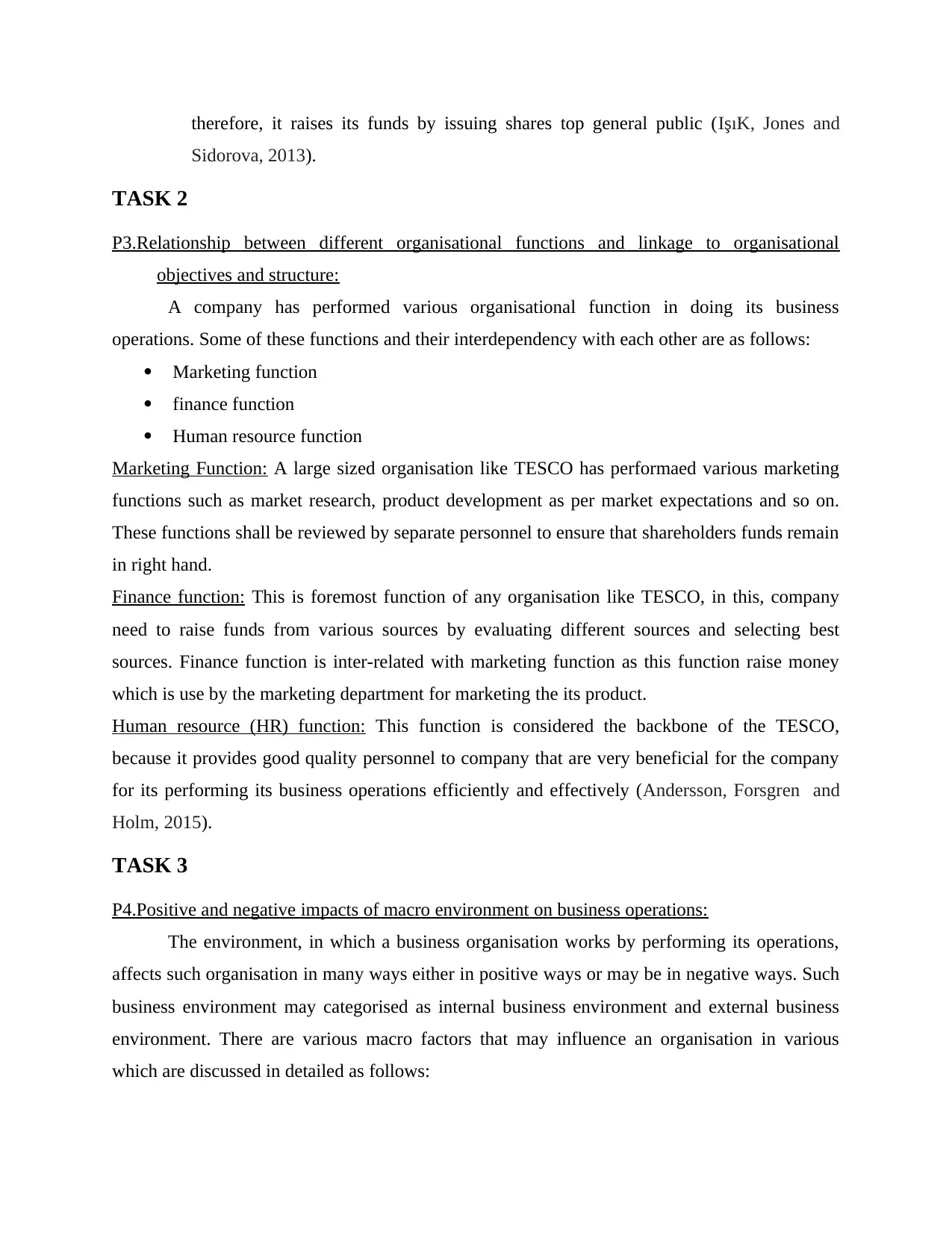
therefore, it raises its funds by issuing shares top general public (IşıK, Jones and
Sidorova, 2013).
TASK 2
P3.Relationship between different organisational functions and linkage to organisational
objectives and structure:
A company has performed various organisational function in doing its business
operations. Some of these functions and their interdependency with each other are as follows:
Marketing function
finance function
Human resource function
Marketing Function: A large sized organisation like TESCO has performaed various marketing
functions such as market research, product development as per market expectations and so on.
These functions shall be reviewed by separate personnel to ensure that shareholders funds remain
in right hand.
Finance function: This is foremost function of any organisation like TESCO, in this, company
need to raise funds from various sources by evaluating different sources and selecting best
sources. Finance function is inter-related with marketing function as this function raise money
which is use by the marketing department for marketing the its product.
Human resource (HR) function: This function is considered the backbone of the TESCO,
because it provides good quality personnel to company that are very beneficial for the company
for its performing its business operations efficiently and effectively (Andersson, Forsgren and
Holm, 2015).
TASK 3
P4.Positive and negative impacts of macro environment on business operations:
The environment, in which a business organisation works by performing its operations,
affects such organisation in many ways either in positive ways or may be in negative ways. Such
business environment may categorised as internal business environment and external business
environment. There are various macro factors that may influence an organisation in various
which are discussed in detailed as follows:
Sidorova, 2013).
TASK 2
P3.Relationship between different organisational functions and linkage to organisational
objectives and structure:
A company has performed various organisational function in doing its business
operations. Some of these functions and their interdependency with each other are as follows:
Marketing function
finance function
Human resource function
Marketing Function: A large sized organisation like TESCO has performaed various marketing
functions such as market research, product development as per market expectations and so on.
These functions shall be reviewed by separate personnel to ensure that shareholders funds remain
in right hand.
Finance function: This is foremost function of any organisation like TESCO, in this, company
need to raise funds from various sources by evaluating different sources and selecting best
sources. Finance function is inter-related with marketing function as this function raise money
which is use by the marketing department for marketing the its product.
Human resource (HR) function: This function is considered the backbone of the TESCO,
because it provides good quality personnel to company that are very beneficial for the company
for its performing its business operations efficiently and effectively (Andersson, Forsgren and
Holm, 2015).
TASK 3
P4.Positive and negative impacts of macro environment on business operations:
The environment, in which a business organisation works by performing its operations,
affects such organisation in many ways either in positive ways or may be in negative ways. Such
business environment may categorised as internal business environment and external business
environment. There are various macro factors that may influence an organisation in various
which are discussed in detailed as follows:
Paraphrase This Document
Need a fresh take? Get an instant paraphrase of this document with our AI Paraphraser
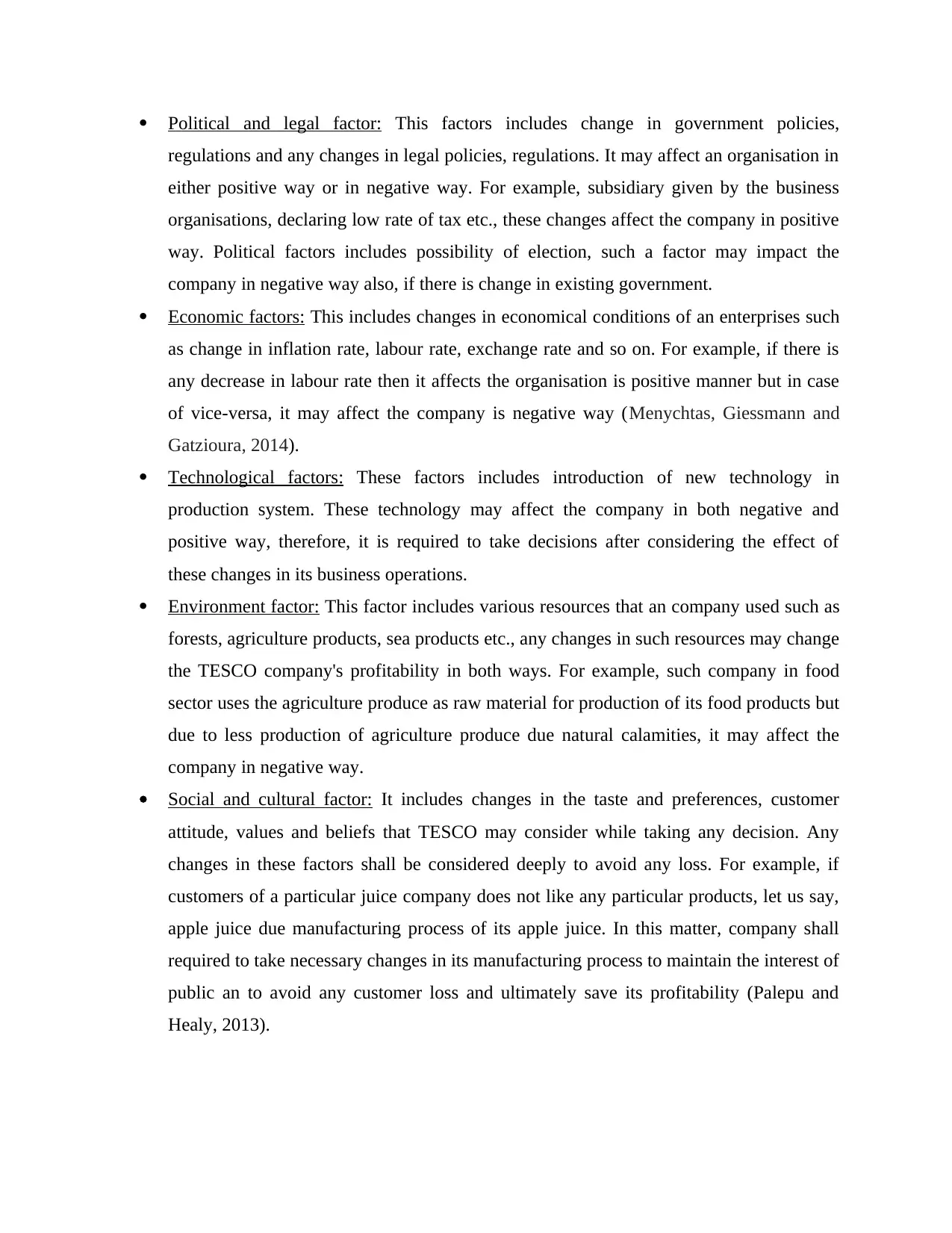
Political and legal factor: This factors includes change in government policies,
regulations and any changes in legal policies, regulations. It may affect an organisation in
either positive way or in negative way. For example, subsidiary given by the business
organisations, declaring low rate of tax etc., these changes affect the company in positive
way. Political factors includes possibility of election, such a factor may impact the
company in negative way also, if there is change in existing government.
Economic factors: This includes changes in economical conditions of an enterprises such
as change in inflation rate, labour rate, exchange rate and so on. For example, if there is
any decrease in labour rate then it affects the organisation is positive manner but in case
of vice-versa, it may affect the company is negative way (Menychtas, Giessmann and
Gatzioura, 2014).
Technological factors: These factors includes introduction of new technology in
production system. These technology may affect the company in both negative and
positive way, therefore, it is required to take decisions after considering the effect of
these changes in its business operations.
Environment factor: This factor includes various resources that an company used such as
forests, agriculture products, sea products etc., any changes in such resources may change
the TESCO company's profitability in both ways. For example, such company in food
sector uses the agriculture produce as raw material for production of its food products but
due to less production of agriculture produce due natural calamities, it may affect the
company in negative way.
Social and cultural factor: It includes changes in the taste and preferences, customer
attitude, values and beliefs that TESCO may consider while taking any decision. Any
changes in these factors shall be considered deeply to avoid any loss. For example, if
customers of a particular juice company does not like any particular products, let us say,
apple juice due manufacturing process of its apple juice. In this matter, company shall
required to take necessary changes in its manufacturing process to maintain the interest of
public an to avoid any customer loss and ultimately save its profitability (Palepu and
Healy, 2013).
regulations and any changes in legal policies, regulations. It may affect an organisation in
either positive way or in negative way. For example, subsidiary given by the business
organisations, declaring low rate of tax etc., these changes affect the company in positive
way. Political factors includes possibility of election, such a factor may impact the
company in negative way also, if there is change in existing government.
Economic factors: This includes changes in economical conditions of an enterprises such
as change in inflation rate, labour rate, exchange rate and so on. For example, if there is
any decrease in labour rate then it affects the organisation is positive manner but in case
of vice-versa, it may affect the company is negative way (Menychtas, Giessmann and
Gatzioura, 2014).
Technological factors: These factors includes introduction of new technology in
production system. These technology may affect the company in both negative and
positive way, therefore, it is required to take decisions after considering the effect of
these changes in its business operations.
Environment factor: This factor includes various resources that an company used such as
forests, agriculture products, sea products etc., any changes in such resources may change
the TESCO company's profitability in both ways. For example, such company in food
sector uses the agriculture produce as raw material for production of its food products but
due to less production of agriculture produce due natural calamities, it may affect the
company in negative way.
Social and cultural factor: It includes changes in the taste and preferences, customer
attitude, values and beliefs that TESCO may consider while taking any decision. Any
changes in these factors shall be considered deeply to avoid any loss. For example, if
customers of a particular juice company does not like any particular products, let us say,
apple juice due manufacturing process of its apple juice. In this matter, company shall
required to take necessary changes in its manufacturing process to maintain the interest of
public an to avoid any customer loss and ultimately save its profitability (Palepu and
Healy, 2013).
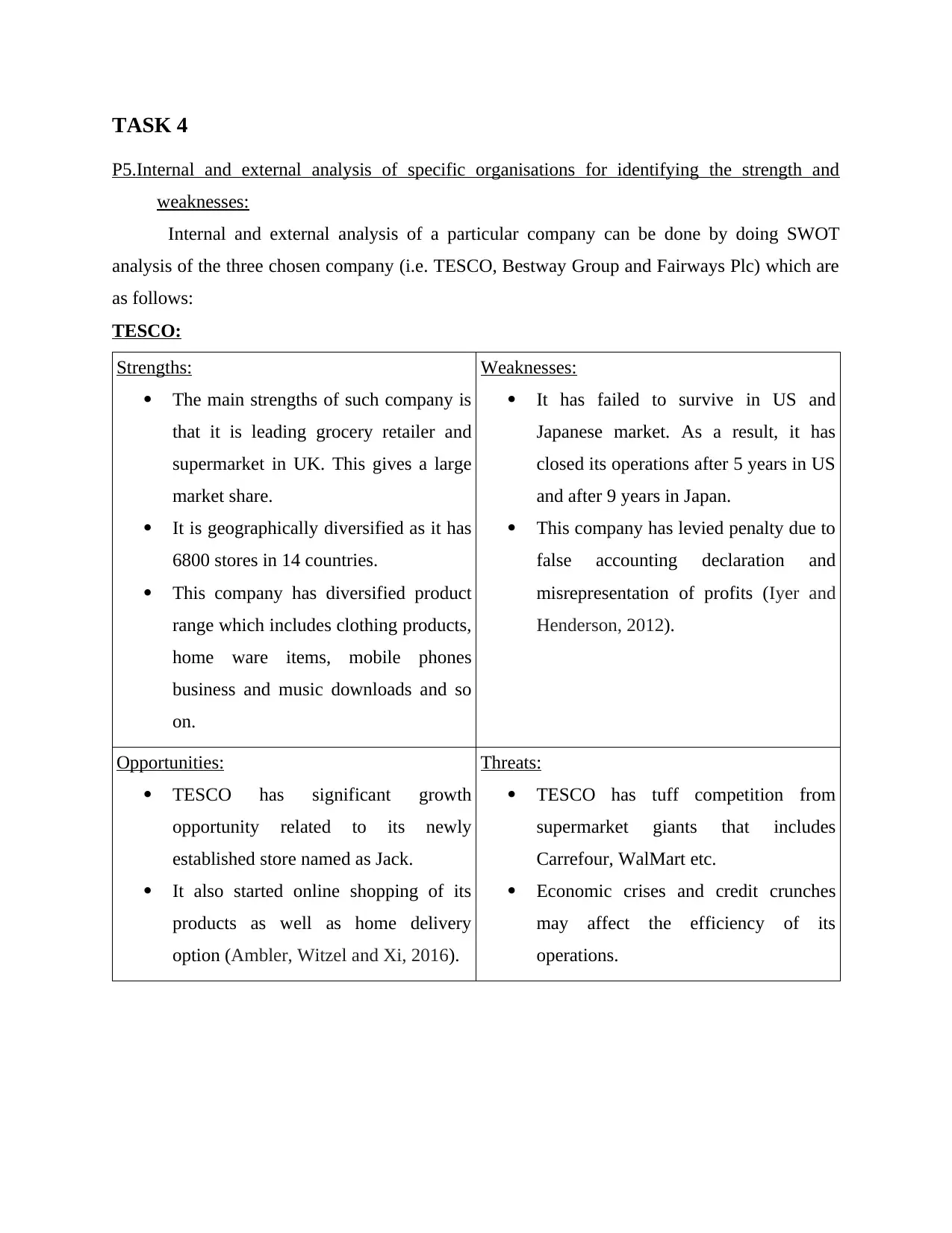
TASK 4
P5.Internal and external analysis of specific organisations for identifying the strength and
weaknesses:
Internal and external analysis of a particular company can be done by doing SWOT
analysis of the three chosen company (i.e. TESCO, Bestway Group and Fairways Plc) which are
as follows:
TESCO:
Strengths:
The main strengths of such company is
that it is leading grocery retailer and
supermarket in UK. This gives a large
market share.
It is geographically diversified as it has
6800 stores in 14 countries.
This company has diversified product
range which includes clothing products,
home ware items, mobile phones
business and music downloads and so
on.
Weaknesses:
It has failed to survive in US and
Japanese market. As a result, it has
closed its operations after 5 years in US
and after 9 years in Japan.
This company has levied penalty due to
false accounting declaration and
misrepresentation of profits (Iyer and
Henderson, 2012).
Opportunities:
TESCO has significant growth
opportunity related to its newly
established store named as Jack.
It also started online shopping of its
products as well as home delivery
option (Ambler, Witzel and Xi, 2016).
Threats:
TESCO has tuff competition from
supermarket giants that includes
Carrefour, WalMart etc.
Economic crises and credit crunches
may affect the efficiency of its
operations.
P5.Internal and external analysis of specific organisations for identifying the strength and
weaknesses:
Internal and external analysis of a particular company can be done by doing SWOT
analysis of the three chosen company (i.e. TESCO, Bestway Group and Fairways Plc) which are
as follows:
TESCO:
Strengths:
The main strengths of such company is
that it is leading grocery retailer and
supermarket in UK. This gives a large
market share.
It is geographically diversified as it has
6800 stores in 14 countries.
This company has diversified product
range which includes clothing products,
home ware items, mobile phones
business and music downloads and so
on.
Weaknesses:
It has failed to survive in US and
Japanese market. As a result, it has
closed its operations after 5 years in US
and after 9 years in Japan.
This company has levied penalty due to
false accounting declaration and
misrepresentation of profits (Iyer and
Henderson, 2012).
Opportunities:
TESCO has significant growth
opportunity related to its newly
established store named as Jack.
It also started online shopping of its
products as well as home delivery
option (Ambler, Witzel and Xi, 2016).
Threats:
TESCO has tuff competition from
supermarket giants that includes
Carrefour, WalMart etc.
Economic crises and credit crunches
may affect the efficiency of its
operations.
⊘ This is a preview!⊘
Do you want full access?
Subscribe today to unlock all pages.

Trusted by 1+ million students worldwide
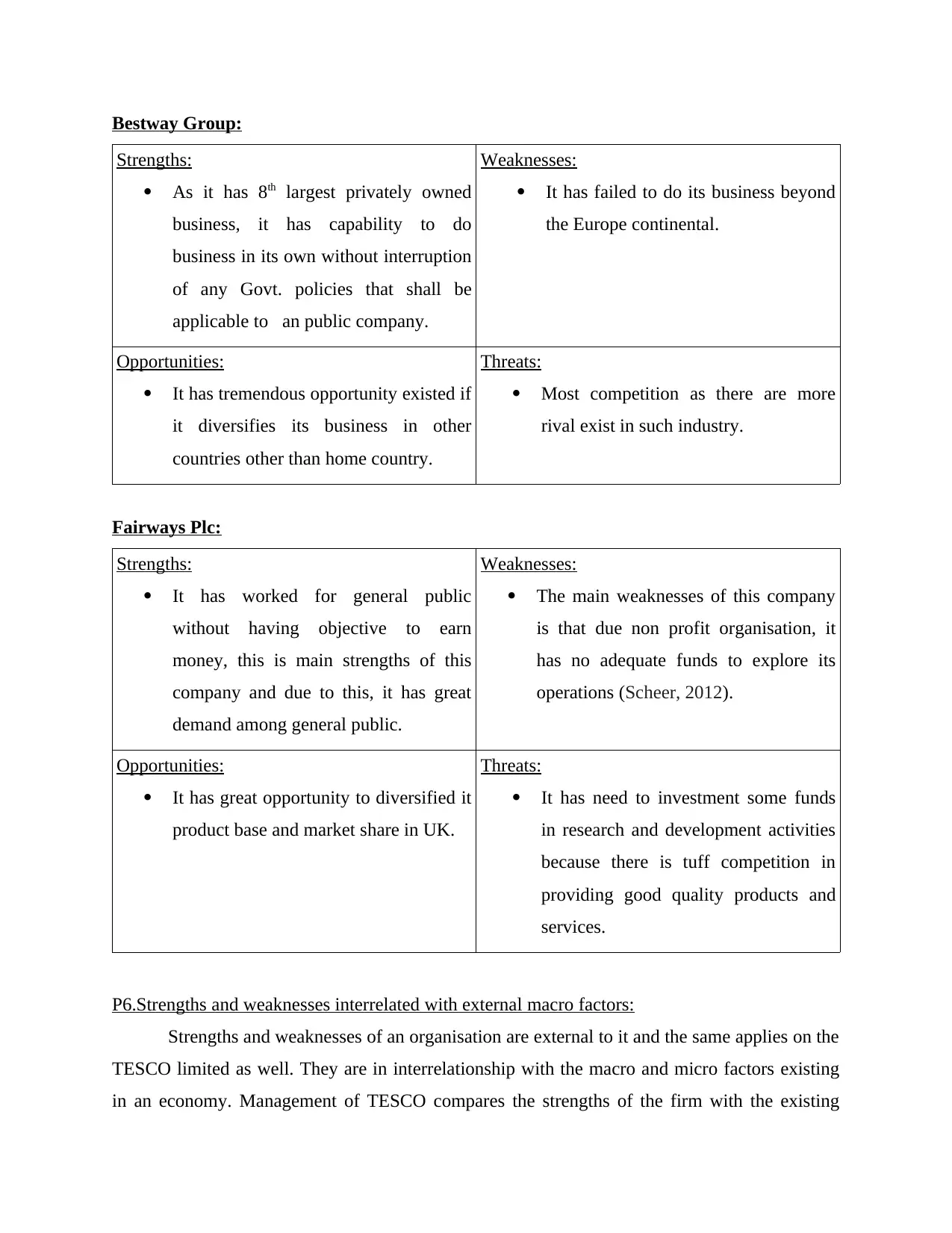
Bestway Group:
Strengths:
As it has 8th largest privately owned
business, it has capability to do
business in its own without interruption
of any Govt. policies that shall be
applicable to an public company.
Weaknesses:
It has failed to do its business beyond
the Europe continental.
Opportunities:
It has tremendous opportunity existed if
it diversifies its business in other
countries other than home country.
Threats:
Most competition as there are more
rival exist in such industry.
Fairways Plc:
Strengths:
It has worked for general public
without having objective to earn
money, this is main strengths of this
company and due to this, it has great
demand among general public.
Weaknesses:
The main weaknesses of this company
is that due non profit organisation, it
has no adequate funds to explore its
operations (Scheer, 2012).
Opportunities:
It has great opportunity to diversified it
product base and market share in UK.
Threats:
It has need to investment some funds
in research and development activities
because there is tuff competition in
providing good quality products and
services.
P6.Strengths and weaknesses interrelated with external macro factors:
Strengths and weaknesses of an organisation are external to it and the same applies on the
TESCO limited as well. They are in interrelationship with the macro and micro factors existing
in an economy. Management of TESCO compares the strengths of the firm with the existing
Strengths:
As it has 8th largest privately owned
business, it has capability to do
business in its own without interruption
of any Govt. policies that shall be
applicable to an public company.
Weaknesses:
It has failed to do its business beyond
the Europe continental.
Opportunities:
It has tremendous opportunity existed if
it diversifies its business in other
countries other than home country.
Threats:
Most competition as there are more
rival exist in such industry.
Fairways Plc:
Strengths:
It has worked for general public
without having objective to earn
money, this is main strengths of this
company and due to this, it has great
demand among general public.
Weaknesses:
The main weaknesses of this company
is that due non profit organisation, it
has no adequate funds to explore its
operations (Scheer, 2012).
Opportunities:
It has great opportunity to diversified it
product base and market share in UK.
Threats:
It has need to investment some funds
in research and development activities
because there is tuff competition in
providing good quality products and
services.
P6.Strengths and weaknesses interrelated with external macro factors:
Strengths and weaknesses of an organisation are external to it and the same applies on the
TESCO limited as well. They are in interrelationship with the macro and micro factors existing
in an economy. Management of TESCO compares the strengths of the firm with the existing
Paraphrase This Document
Need a fresh take? Get an instant paraphrase of this document with our AI Paraphraser
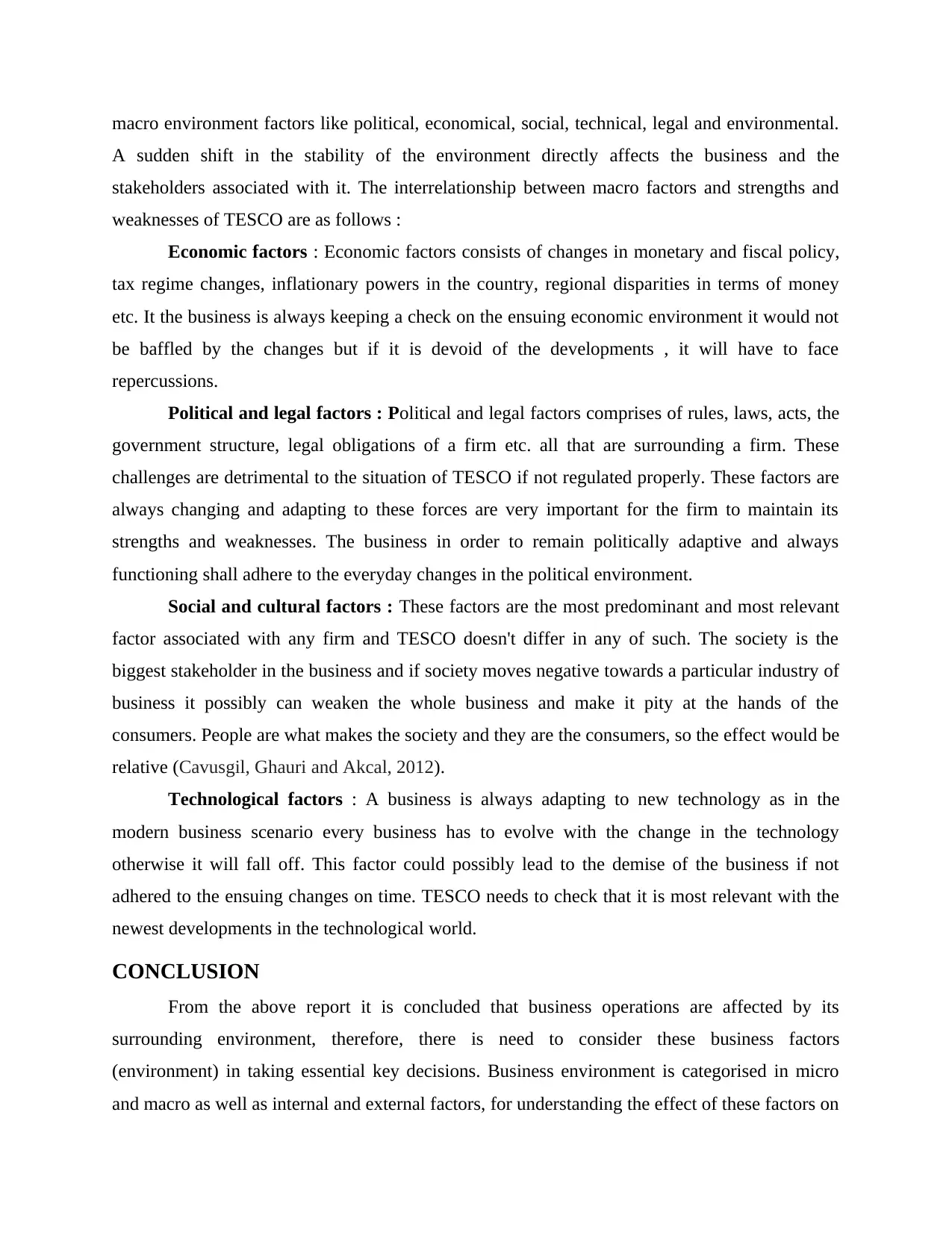
macro environment factors like political, economical, social, technical, legal and environmental.
A sudden shift in the stability of the environment directly affects the business and the
stakeholders associated with it. The interrelationship between macro factors and strengths and
weaknesses of TESCO are as follows :
Economic factors : Economic factors consists of changes in monetary and fiscal policy,
tax regime changes, inflationary powers in the country, regional disparities in terms of money
etc. It the business is always keeping a check on the ensuing economic environment it would not
be baffled by the changes but if it is devoid of the developments , it will have to face
repercussions.
Political and legal factors : Political and legal factors comprises of rules, laws, acts, the
government structure, legal obligations of a firm etc. all that are surrounding a firm. These
challenges are detrimental to the situation of TESCO if not regulated properly. These factors are
always changing and adapting to these forces are very important for the firm to maintain its
strengths and weaknesses. The business in order to remain politically adaptive and always
functioning shall adhere to the everyday changes in the political environment.
Social and cultural factors : These factors are the most predominant and most relevant
factor associated with any firm and TESCO doesn't differ in any of such. The society is the
biggest stakeholder in the business and if society moves negative towards a particular industry of
business it possibly can weaken the whole business and make it pity at the hands of the
consumers. People are what makes the society and they are the consumers, so the effect would be
relative (Cavusgil, Ghauri and Akcal, 2012).
Technological factors : A business is always adapting to new technology as in the
modern business scenario every business has to evolve with the change in the technology
otherwise it will fall off. This factor could possibly lead to the demise of the business if not
adhered to the ensuing changes on time. TESCO needs to check that it is most relevant with the
newest developments in the technological world.
CONCLUSION
From the above report it is concluded that business operations are affected by its
surrounding environment, therefore, there is need to consider these business factors
(environment) in taking essential key decisions. Business environment is categorised in micro
and macro as well as internal and external factors, for understanding the effect of these factors on
A sudden shift in the stability of the environment directly affects the business and the
stakeholders associated with it. The interrelationship between macro factors and strengths and
weaknesses of TESCO are as follows :
Economic factors : Economic factors consists of changes in monetary and fiscal policy,
tax regime changes, inflationary powers in the country, regional disparities in terms of money
etc. It the business is always keeping a check on the ensuing economic environment it would not
be baffled by the changes but if it is devoid of the developments , it will have to face
repercussions.
Political and legal factors : Political and legal factors comprises of rules, laws, acts, the
government structure, legal obligations of a firm etc. all that are surrounding a firm. These
challenges are detrimental to the situation of TESCO if not regulated properly. These factors are
always changing and adapting to these forces are very important for the firm to maintain its
strengths and weaknesses. The business in order to remain politically adaptive and always
functioning shall adhere to the everyday changes in the political environment.
Social and cultural factors : These factors are the most predominant and most relevant
factor associated with any firm and TESCO doesn't differ in any of such. The society is the
biggest stakeholder in the business and if society moves negative towards a particular industry of
business it possibly can weaken the whole business and make it pity at the hands of the
consumers. People are what makes the society and they are the consumers, so the effect would be
relative (Cavusgil, Ghauri and Akcal, 2012).
Technological factors : A business is always adapting to new technology as in the
modern business scenario every business has to evolve with the change in the technology
otherwise it will fall off. This factor could possibly lead to the demise of the business if not
adhered to the ensuing changes on time. TESCO needs to check that it is most relevant with the
newest developments in the technological world.
CONCLUSION
From the above report it is concluded that business operations are affected by its
surrounding environment, therefore, there is need to consider these business factors
(environment) in taking essential key decisions. Business environment is categorised in micro
and macro as well as internal and external factors, for understanding the effect of these factors on

the company's operations, there is requirements that company shall conduct various analysis
technique such as SWOT, PESTAL and so on. It is further concluded that legal structure and size
are also affected the the company's future operations, therefore company has to keep in mind
these factor before starting any new business line.
REFERENCES
Books and Journal:
Hilton, R.W. and Platt, D.E., 2013. Managerial accounting: creating value in a dynamic
business environment. McGraw-Hill Education.
Hillary, R., 2017. Small and medium-sized enterprises and the environment: business
imperatives. Routledge.
technique such as SWOT, PESTAL and so on. It is further concluded that legal structure and size
are also affected the the company's future operations, therefore company has to keep in mind
these factor before starting any new business line.
REFERENCES
Books and Journal:
Hilton, R.W. and Platt, D.E., 2013. Managerial accounting: creating value in a dynamic
business environment. McGraw-Hill Education.
Hillary, R., 2017. Small and medium-sized enterprises and the environment: business
imperatives. Routledge.
⊘ This is a preview!⊘
Do you want full access?
Subscribe today to unlock all pages.

Trusted by 1+ million students worldwide
1 out of 13
Related Documents
Your All-in-One AI-Powered Toolkit for Academic Success.
+13062052269
info@desklib.com
Available 24*7 on WhatsApp / Email
![[object Object]](/_next/static/media/star-bottom.7253800d.svg)
Unlock your academic potential
Copyright © 2020–2025 A2Z Services. All Rights Reserved. Developed and managed by ZUCOL.





